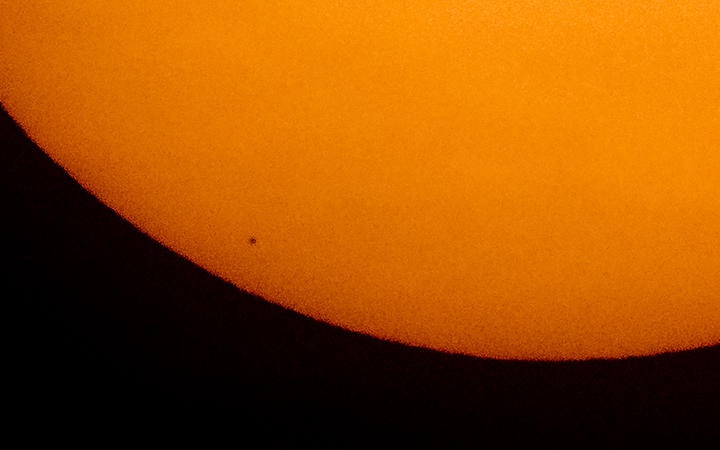Keen stargazers gathered at Te Whanganui o Hei, or Mercury Bay, on the Coromandel Peninsula to watch a rare astronomic event this morning.

Mercury in silhouette, low center, as it transits across the face of the Sun on 11 November, 2019, from Washington, DC. Photo: Bill Ingalls / NASA / AFP
The transit of Mercury was visible across New Zealand this morning as it moved across the sun - the planetary phenomenon happens around 13 times every century.
The transit appears as a tiny dot moving across the sun, and people at Mercury Bay saw the last hour of its transit.
Otago Museum director Ian Griffin, who was among those watching today, said the location was significant because Mercury Bay got its european name when Captain Cook berthed there so that an astronomer onboard, Charles Green, could observe the event in 1769.
"That particular observation was the very first time, I think, telescopes were used in New Zealand and very interestingly we see it 250 years later," he told Morning Report.
"But through a completely coincidental complexity of maths and resonance, there's going to be another transit of mercury on the 500 anniversary in 2269, so it's kind of marking the pulses of the first contact between Pākehā and Māori."
He said this was an opportunity to reflect on the past, and seeing the many different members of community at the beach today made him wonder about the future and communities working together for the next 250 years.
"Everybody
got to see this little tiny silhouette moving across the
sun" - Ian Griffin, Otago Museum director duration
3:03
from
Morning Report
Click a link to play audio (or right-click to
download) in either
MP3 format or in OGG format.
Mr Griffin told Morning Report they had telescopes on-site - courtesy of a grant from a Tuia 250 programme - since the transit is not visible to the naked eye.
He said he was ecstatic after the viewing this morning, in which he reckons about more than 100 people turned up.
"We could see prominences on the sun, which Cook and Green could never have seen, because my understanding is that their telescopes were protected by basically hot candle wax darkening on a piece of glass to protect the eyes, we were much safer but we could see a lot of detail."
The next time a transit of Mercury would be visible from New Zealand is 2039, "so you'll have a wee time to wait", Mr Griffin said.



 Richard S. Ehrlich: China's Great Wall & Egypt's Pyramids
Richard S. Ehrlich: China's Great Wall & Egypt's Pyramids Gordon Campbell: On Surviving Trump’s Trip To La La Land
Gordon Campbell: On Surviving Trump’s Trip To La La Land Ramzy Baroud: Famine In Gaza - Will We Continue To Watch As Gaza Starves To Death?
Ramzy Baroud: Famine In Gaza - Will We Continue To Watch As Gaza Starves To Death? Peter Dunne: Dunne's Weekly - A Government Backbencher's Lot Not Always A Happy One
Peter Dunne: Dunne's Weekly - A Government Backbencher's Lot Not Always A Happy One Richard S. Ehrlich: Cyber-Spying 'From Lhasa To London' & Tibet Flexing
Richard S. Ehrlich: Cyber-Spying 'From Lhasa To London' & Tibet Flexing Gordon Campbell: On Aussie Election Aftershocks And Life Lessons
Gordon Campbell: On Aussie Election Aftershocks And Life Lessons